Tom's Hardware Verdict
With QLC NAND, Sabrent’s Rocket XTRM-Q aims to undercut most of its TLC-based competition while still delivering the storage goods. Not only does it come in high capacities, but the Rocket XRTM-Q is also very fast, performing well on both Thunderbolt 3 and USB hosts.
Pros
- +
Sleek looks
- +
Highest-capacity TB3 portable SSD
- +
USB and Thunderbolt 3 compatibility
- +
Competitive performance and pricing
- +
Warranty up to five years
- +
Included cables are long
Cons
- -
One-year warranty without registration
- -
Slow write speed after write cache fills
- -
Lacks 256-bit AES hardware encryption
- -
Lacks IP rating
Why you can trust Tom's Hardware
Sabrent is on a roll lately, and the Rocket XTRM-Q continues that momentum. Not only is the company serving up some of the world’s fastest and highest-capacity consumer M.2 SSDs, but Sabrent is also taking the high-end external market by storm. Sabrent’s Rocket XTRM-Q external SSD offers both USB and Thunderbolt 3 operation for flexibility and fast performance, as well as the industry's highest capacities for such a device. It’s unsurprising that the 4TB and 8TB capacities carry high price tags. But it is a bit disappointing that the drive lacks the weatherproofing some of its competitors. And it can slow down quite significantly during large transfers.
Compatible with Windows, Mac and Android devices and sporting both USB 3.2 Gen 2 and Thunderbolt 3 controllers, Sabrent’s Rocket XTRM-Q is great for those who want speed and capacity across platforms. And with a shell crafted out of solid aluminum, the drive is not only durable, it’s also the smallest and lightest Thunderbolt 3 SSD we’ve tested yet, too.
Specifications
| Product | Rocket XTRM-Q 500GB | Rocket XTRM-Q 1TB | Rocket XTRM-Q 2TB | Rocket XTRM-Q 4TB | Rocket XTRM-Q 8TB |
|---|---|---|---|---|---|
| Pricing | $169.99 | $219.99 | $359.99 | $829.99 | $1,599.99 |
| Capacity (User / Raw) | 500GB / 512GB | 1000GB / 1024GB | 2000GB / 2048GB | 4000GB / 4096GB | 8000GB / 8192GB |
| Interface / Protocol | USB-C / Thunderbolt 3; USB 3.2 Gen 2 | USB-C / Thunderbolt 3; USB 3.2 Gen 2 | USB-C / Thunderbolt 3; USB 3.2 Gen 2 | USB-C / Thunderbolt 3; USB 3.2 Gen 2 | USB-C / Thunderbolt 3; USB 3.2 Gen 2 |
| Included | 27-inch Thunderbolt 3 (40Gbps) cable; 20-inch USB Type-C to Type-A (10GBps) cable | 27-inch Thunderbolt 3 (40Gbps) cable; 20-inch USB Type-C to Type-A (10GBps) cable | 27-inch Thunderbolt 3 (40Gbps) cable; 20-inch USB Type-C to Type-A (10GBps) cable | 27-inch Thunderbolt 3 (40Gbps) cable; 20-inch USB Type-C to Type-A (10GBps) cable | 27-inch Thunderbolt 3 (40Gbps) cable; 20-inch USB Type-C to Type-A (10GBps) cable |
| Thunderbolt 3 Sequential Read | 2,700 MBps | 2,700 MBps | 2,700 MBps | 2,700 MBps | 2,700 MBps |
| USB 3.2 Gen2 Sequential Read | 900 MBps | 900 MBps | 900 MBps | 900 MBps | 900 MBps |
| Interface Controller | Thunderbolt 3 - Intel JHL7440; | Thunderbolt 3 - Intel JHL7440; | Thunderbolt 3 - Intel JHL7440; | Thunderbolt 3 - Intel JHL7440; | Thunderbolt 3 - Intel JHL7440; |
| USB - Realtek 9108B | USB - Realtek 9108B | USB - Realtek 9108B | USB - Realtek 9108B | USB - Realtek 9108B | |
| NAND Controller | Phison E12S | Phison E12S | Phison E12S | Phison E12S | Phison E12S |
| DRAM | DDR3L | DDR3L | DDR3L | DDR3L | DDR3L |
| Storage Media | Micron 96L QLC | Micron 96L QLC | Micron 96L QLC | Micron 96L QLC | Micron 96L QLC |
| Default File System | exFAT | exFAT | exFAT | exFAT | exFAT |
| Power | Bus-powered | Bus-powered | Bus-powered | Bus-powered | Bus-powered |
| Security | N/A | N/A | N/A | N/A | N/A |
| Dimensions (L x W x H) | 105 x 45 x 14 mm | 105 x 45 x 14 mm | 105 x 45 x 14 mm | 105 x 45 x 14 mm | 105 x 45 x 14 mm |
| Weight | 129 g | 129 g | 129 g | 129 g | 129 g |
| Part Number | SB-XTMQ-500 | SB-XTMQ-1TB | SB-XTMQ-2TB | SB-XTMQ-4TB | SB-XTMQ-8TB |
| Warranty | 5-Years | 5-Years | 5-Years | 5-Years | 5-Years |
Sabrent’s Rocket XTRM-Q is available in capacities as small as 500GB and as large as 8TB, which is larger than what most other major manufacturers currently have available. And at prices that range from $0.18-0.34 per GB, the drive is priced very aggressively, undercutting most Thunderbolt 3 (TB3) devices in the market capacity for capacity. The cheaper QLC-NAND flash makes this SSD perfect for value seekers, especially at the smaller capacities. But the 4TB and 8TB models cost as much as a gaming PC by themselves.
The portable SSD comes formatted as exFAT drive out of the box and dishes out read performance figures of up to 2.7 GBps. While not specified by Sabrent, the Rocket XTRM-Q’s sequential write performance peaked at 1.8 GBps in our testing. However, being powered by QLC NAND flash, that write speed will degrade once the SLC cache fills and the drive is forced to write directly to QLC.
Sabrent’s Rocket XTRM-Q features a large dynamic SLC cache that spans one-quarter of its available capacity. That means if the drive is empty, the cache should absorb roughly 2TB of writes on our 8TB sample before degrading to much lower speeds. It also means that if the drive is 75% full, the SLC cache will only measure roughly 60GB. We will go into more detail on just how write performance degrades later in the review.
Sabrent’s Rocket XTRM-Q comes with a one-year warranty out of the box, but you can extend that to a total of five years by registering it with the company within 90 days. Unlike LaCie’s Rugged SSD Pro or SanDisk’s Extreme Pro, the Rocket XTRM-Q lacks an IP rating, which at lower capacities makes some sense. But when you start spending $800-$1,600 on the larger capacities, weatherproofing becomes an important feature to consider. Sabrent’s Rocket XTRM-Q also lacks security features such as hardware-based encryption, but to be fair, LaCie’s Rugged SSD Pro lacks the feature, too.
Software and Accessories
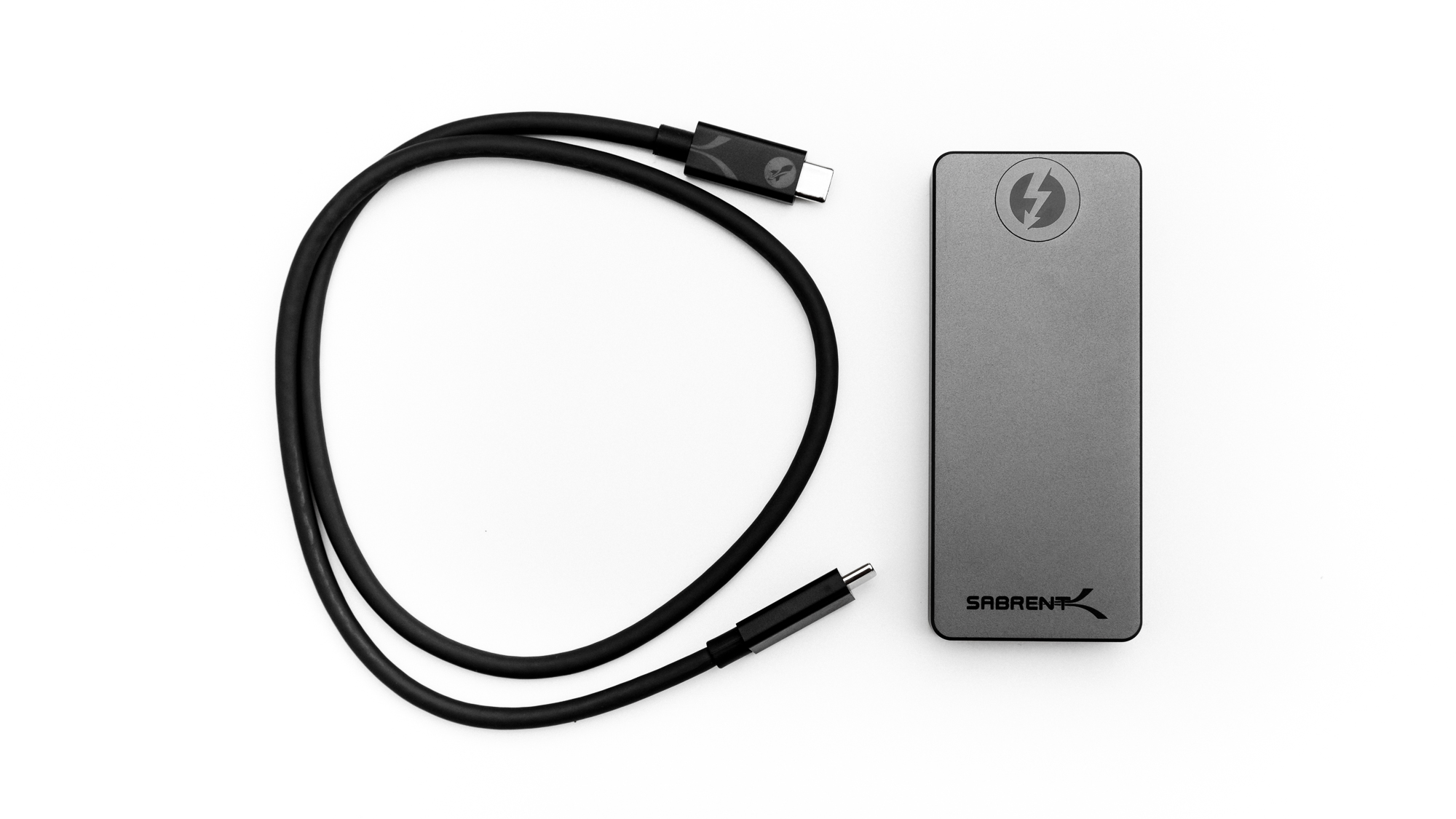

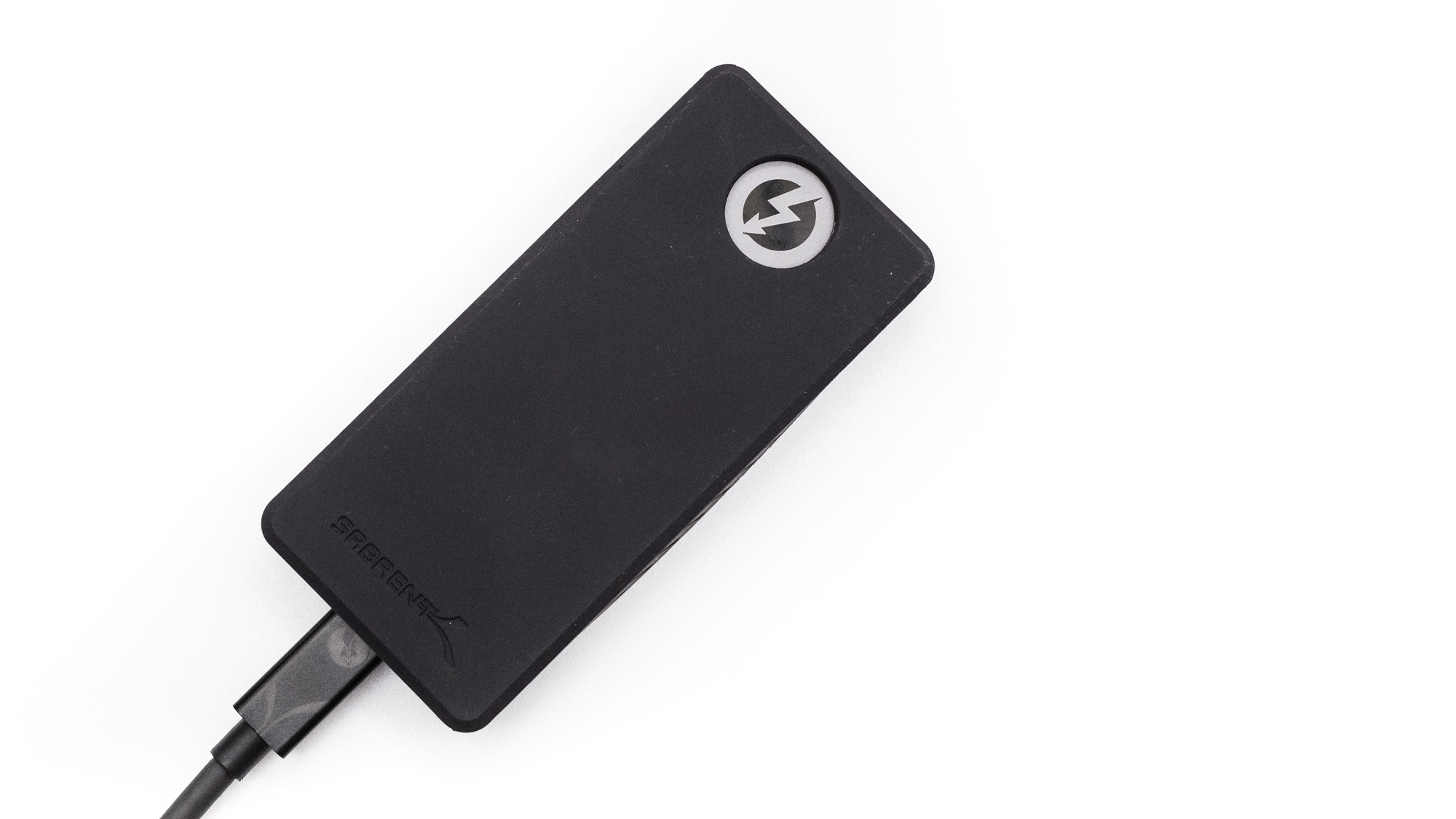

When it comes to supplying the Rocket XTRM-Q’s cables, Sabrent didn’t skimp at all. The SSD comes with two very long cables, one being a 27-inch Thunderbolt 3 (40Gbps) cable and the other a 20-inch USB Type-C to Type-A (10GBps) cable. Our sample also came with a protective silicone case to help protect it against falls while not hindering thermal dissipation too much.
Get Tom's Hardware's best news and in-depth reviews, straight to your inbox.
A Closer Look
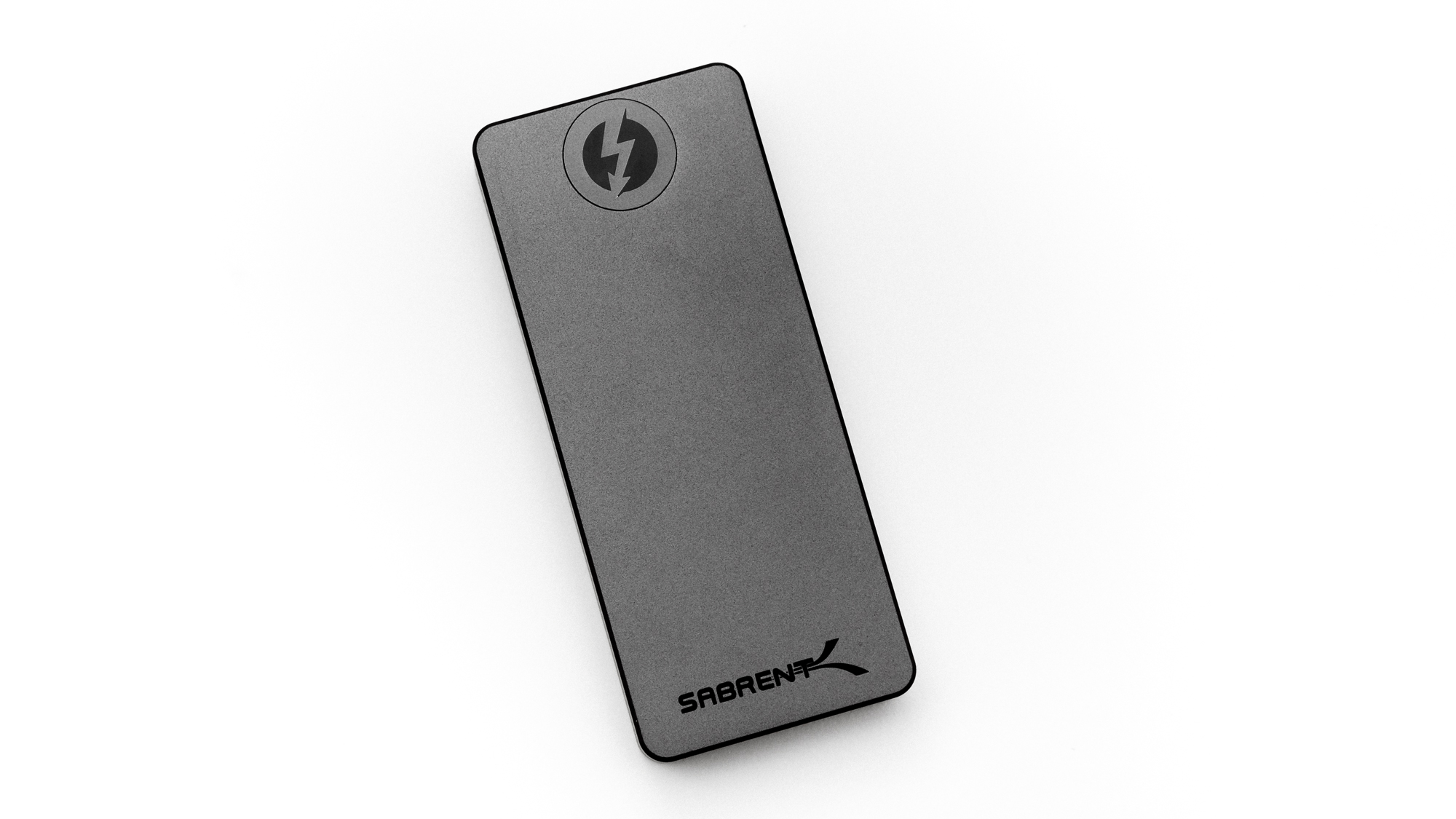

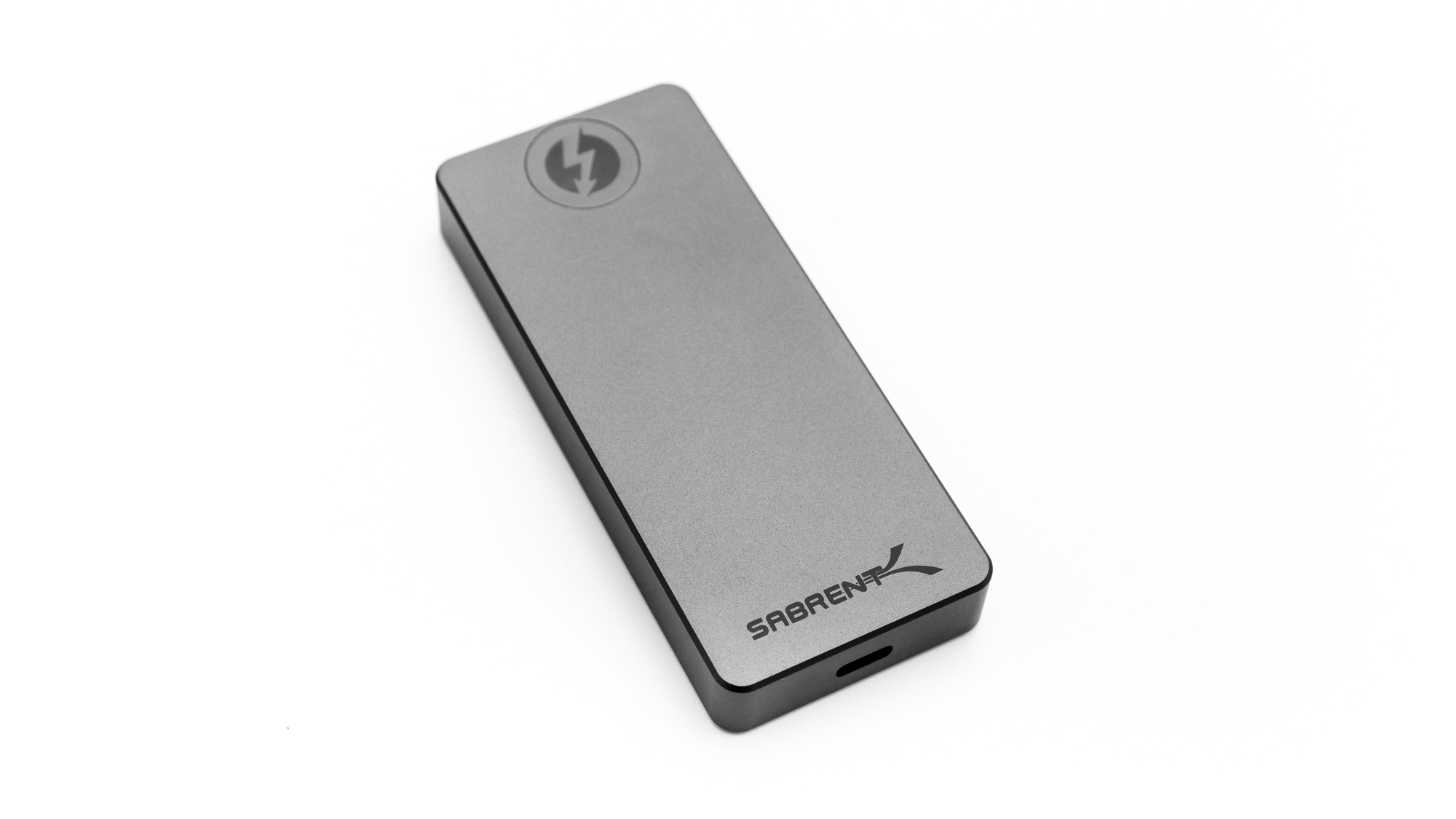

The Rocket XTRM-Q’s smooth, sandblasted finish and beveled edges make for a beautifully designed hunk of metal that is also functional. The drive weighs 129 grams and measures 105mm x 45mm and is only 14mm thick. The solid aluminum construction not only keeps the SSD cool, it’s very durable and gives it some solid protection against drops, although the company doesn’t provide drop test ratings like competitors do.
On the bottom of the SSD are a set of rubber feet to prevent the device from slipping around on a smooth surface. A blue power indicator is on the opposite end of the Thunderbolt 3 / Type-C port. The Rocket XTRM-Q manages the host interface connection via a few PCIe switches and some bridge chips. Managing the Thunderbolt 3 interface is an Intel Titan Ridge JHL7440 40Gbps controller. As for the USB interface, Sabrent opted for Realtek’s RTL9210B USB 3.1 Gen 2 to PCIe 3.0 x2 controller. There’s also support for low-power modes, which help the Rocket XTRM-Q’s idle power consumption and reduce overall heat output.
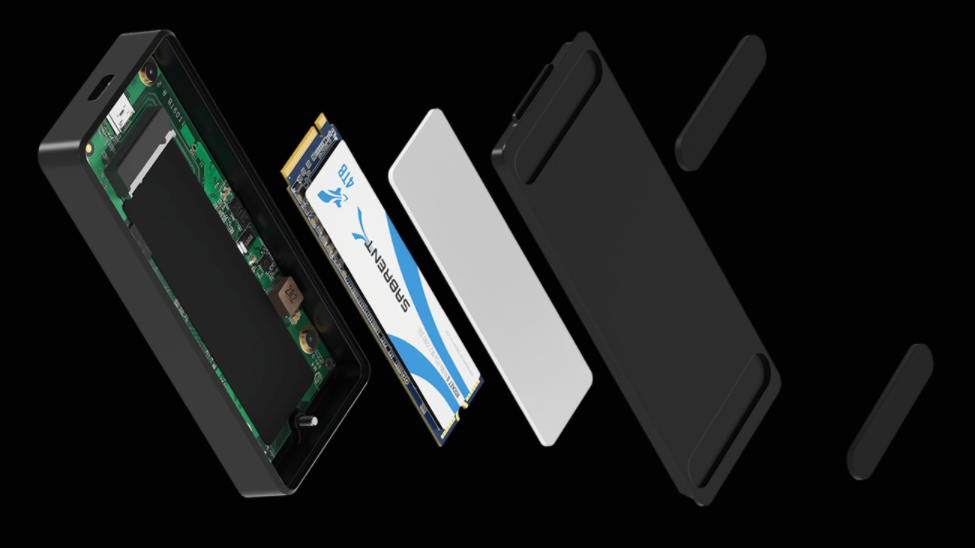
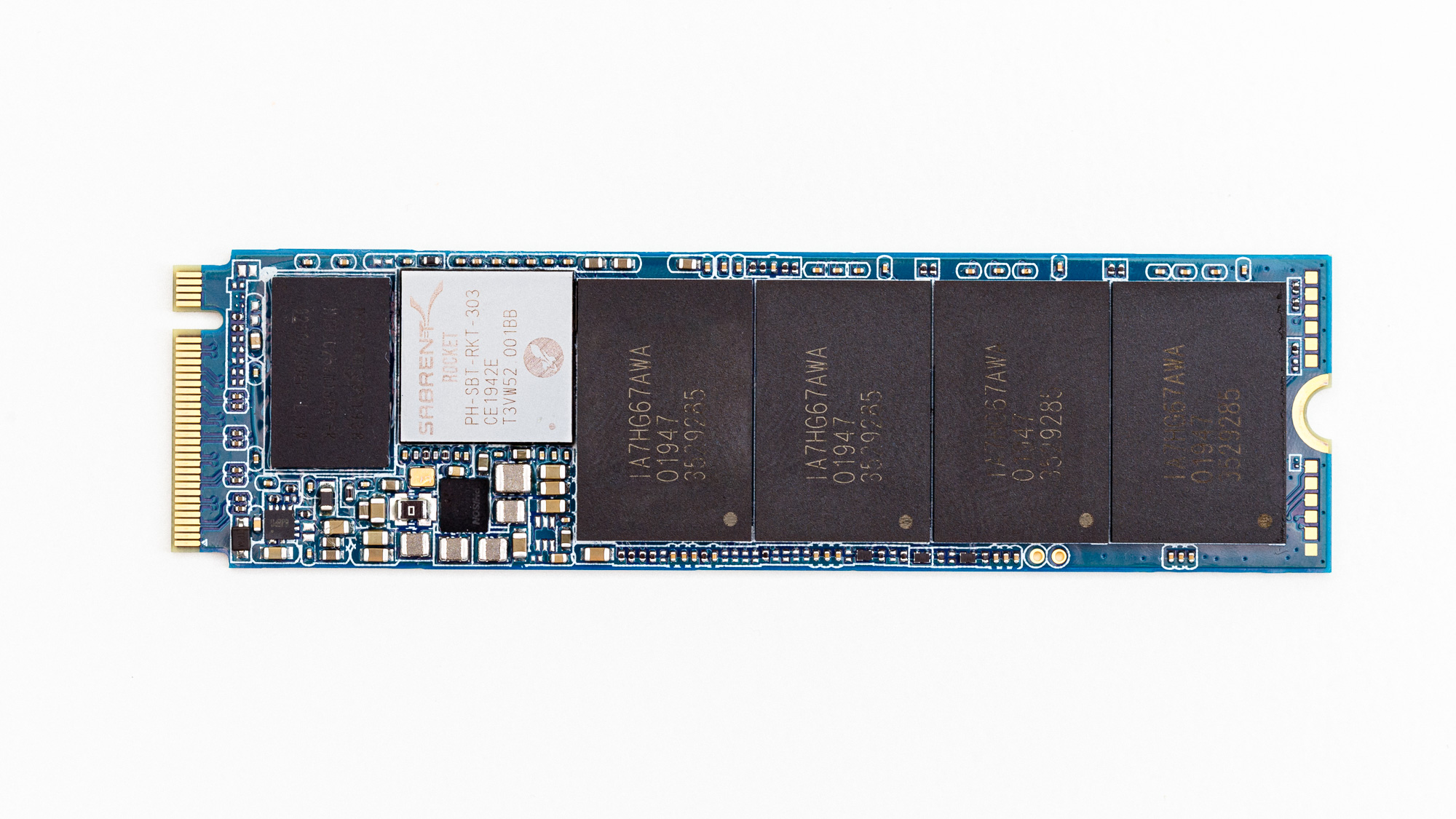

At the heart of the Sabrent Rocket XTRM-Q is the company’s Rocket Q, an M.2 2280 SSD. Powered by Phison’s new E12S PCIe 3.0 x4 NVMe 1.3 SSD controller, it is quite capable. It is built on a 12nm process node, boasts dual Cortex R5 CPUs operating at 666MHz, alongside a pair of co-processors, and leverages a DRAM-based architecture for consistent performance. However, with just two of 1GB DDR3L 1,600MHz DRAM chips for buffering the FTL mapping data, the controller must implement a form of table compression. This helps reduce costs, and from our testing doesn’t seem to hurt the SSD’s performance much at all.
The Phison E12S manages 64 dies of Micron’s latest 1Tb 96L QLC NAND flash over eight NAND channels at a speed of 666MT/s. This NAND features a tile-based architecture and floating gate cell design just like its TLC counterparts, and each die has four virtual planes. Because of this, the NAND is very responsive to random requests. However, the fact that it is QLC NAND flash means that it’s going to have lower performance and endurance than the TLC equivalent. To help increase the Rocket XTRM-Q’s endurance and performance, Sabrent overprovisioned the portable SSD by 9% out of the factory for bad block management and other background tasks. The controller also employs Low-Density Parity-Check (LDPC) ECC and supports Trim.

Sean is a Contributing Editor at Tom’s Hardware US, covering storage hardware.
-
bkuhl "While most competitors still top out at capacities of 2TB, Sabrent’s Rocket XTRM-Q is the only portable SSD available in a covernous 8TB size. "Reply
Covernous? Did you mean cavernous? -
omnitrixpower95 USB 3.2 Gen 3/4/5/6? oh no they have made it even worse than it already was wtfReply -
Rockenrog Despite all the work, it is an Apples and Oranges comparison. If a 1TB version of the Sabrent XTRM-Q were tested the result would have been grossly different. With an empty 1TB XTRM-Q the speed will drop at about 125GB. OK, that is enough for me. But if my drive is 75% full, then the speed will drop off very quickly to slower than USB3.2 speeds!Reply
Come on Sean, no more Apples and Oranges!